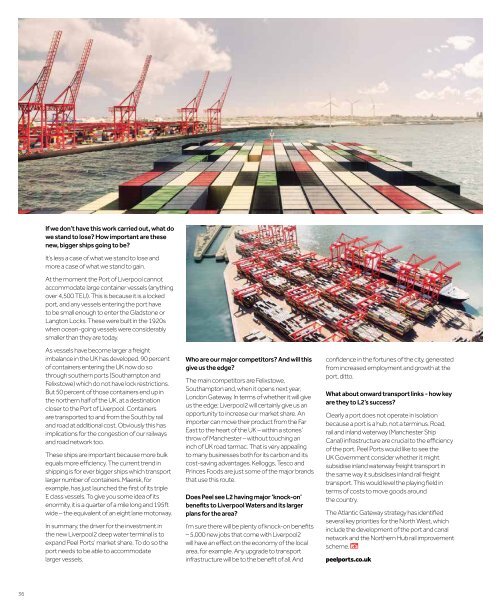here. - It's Liverpool
here. - It's Liverpool
here. - It's Liverpool
Create successful ePaper yourself
Turn your PDF publications into a flip-book with our unique Google optimized e-Paper software.
If we don’t have this work carried out, what dowe stand to lose? How important are thesenew, bigger ships going to be?It’s less a case of what we stand to lose andmore a case of what we stand to gain.At the moment the Port of <strong>Liverpool</strong> cannotaccommodate large container vessels (anythingover 4,500 TEU). This is because it is a lockedport, and any vessels entering the port haveto be small enough to enter the Gladstone orLangton Locks. These were built in the 1920swhen ocean-going vessels were considerablysmaller than they are today.As vessels have become larger a freightimbalance in the UK has developed. 90 percentof containers entering the UK now do sothrough southern ports (Southampton andFelixstowe) which do not have lock restrictions.But 50 percent of those containers end up inthe northern half of the UK, at a destinationcloser to the Port of <strong>Liverpool</strong>. Containersare transported to and from the South by railand road at additional cost. Obviously this hasimplications for the congestion of our railwaysand road network too.These ships are important because more bulkequals more efficiency. The current trend inshipping is for ever bigger ships which transportlarger number of containers. Maersk, forexample, has just launched the first of its tripleE class vessels. To give you some idea of itsenormity, it is a quarter of a mile long and 195ftwide – the equivalent of an eight lane motorway.In summary, the driver for the investment inthe new <strong>Liverpool</strong>2 deep water terminal is toexpand Peel Ports’ market share. To do so theport needs to be able to accommodatelarger vessels.Who are our major competitors? And will thisgive us the edge?The main competitors are Felixstowe,Southampton and, when it opens next year,London Gateway. In terms of whether it will giveus the edge; <strong>Liverpool</strong>2 will certainly give us anopportunity to increase our market share. Animporter can move their product from the FarEast to the heart of the UK – within a stones’throw of Manchester – without touching aninch of UK road tarmac. That is very appealingto many businesses both for its carbon and itscost-saving advantages. Kelloggs, Tesco andPrinces Foods are just some of the major brandsthat use this route.Does Peel see L2 having major ‘knock-on’benefits to <strong>Liverpool</strong> Waters and its largerplans for the area?I’m sure t<strong>here</strong> will be plenty of knock-on benefits– 5,000 new jobs that come with <strong>Liverpool</strong>2will have an effect on the economy of the localarea, for example. Any upgrade to transportinfrastructure will be to the benefit of all. Andconfidence in the fortunes of the city, generatedfrom increased employment and growth at theport, ditto.What about onward transport links - how keyare they to L2’s success?Clearly a port does not operate in isolationbecause a port is a hub, not a terminus. Road,rail and inland waterway (Manchester ShipCanal) infrastructure are crucial to the efficiencyof the port. Peel Ports would like to see theUK Government consider whether it mightsubsidise inland waterway freight transport inthe same way it subsidises inland rail freighttransport. This would level the playing field interms of costs to move goods aroundthe country.The Atlantic Gateway strategy has identifiedseveral key priorities for the North West, whichinclude the development of the port and canalnetwork and the Northern Hub rail improvementscheme.peelports.co.uk36


